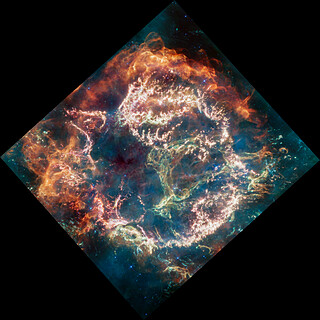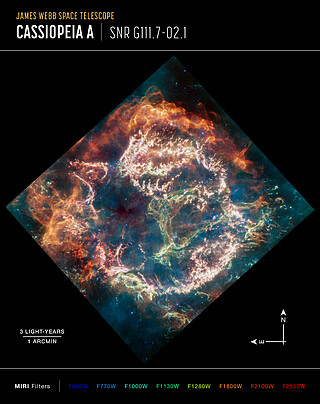weic2311 — Photo Release
Webb reveals new details in Cassiopeia A
7 April 2023
The explosion of a star is a dramatic event, but the remains that the star leaves behind can be even more dramatic. A new mid-infrared image from NASA/ESA/CSA James Webb Space Telescope provides one stunning example. It shows the supernova remnant Cassiopeia A (Cas A), created by a stellar explosion 340 years ago. The image displays vivid colours and intricate structures begging to be examined more closely. Cas A is the youngest known remnant of an exploding, massive star in our galaxy, offering astronomers an opportunity to perform stellar forensics to understand the star’s death.
Cassiopeia A is a prototypical supernova remnant that has been widely studied by a number of ground-based and space-based observatories. The multi-wavelength observations can be combined to provide scientists with a more comprehensive understanding of the remnant.
The striking colours of the new Cas A image, in which infrared light is translated into visible-light wavelengths, hold a wealth of scientific information that researchers are just beginning to tease out. On the bubble’s exterior, particularly at the top and left, lie curtains of material appearing orange and red that are due to emission from warm dust. This marks where ejected material from the exploded star is ramming into surrounding circumstellar gas and dust.
Interior to this outer shell lie mottled filaments of bright pink studded with clumps and knots. This represents material from the star itself, which is shining by the light produced by a mix of heavy elements, such as oxygen, argon, and neon, as well as dust emission. The stellar material can also be seen as fainter wisps near the cavity’s interior.
Among the science questions that Cas A may help answer is: where does cosmic dust come from? Observations have found that even very young galaxies in the early Universe are suffused with massive quantities of dust. It’s difficult to explain the origins of this dust without invoking supernovae, which spew large quantities of heavy elements (the building blocks of dust) across space.
However, existing observations of supernovae have been unable to conclusively explain the amount of dust we see in those early galaxies. By studying Cas A with Webb, astronomers hope to gain a better understanding of its dust content, which can help inform our understanding of where the building blocks of planets — and ourselves — are created.
Supernovae like the one that formed Cas A are crucial for life as we know it. They spread elements like the calcium we find in our bones and the iron in our blood across interstellar space, seeding new generations of stars and planets.
The Cas A remnant spans about 10 light-years and is located 11 000 light-years away in the constellation Cassiopeia.
More information
Webb is the largest, most powerful telescope ever launched into space. Under an international collaboration agreement, ESA provided the telescope’s launch service, using the Ariane 5 launch vehicle. Working with partners, ESA was responsible for the development and qualification of Ariane 5 adaptations for the Webb mission and for the procurement of the launch service by Arianespace. ESA also provided the workhorse spectrograph NIRSpec and 50% of the mid-infrared instrument MIRI, which was designed and built by a consortium of nationally funded European Institutes (The MIRI European Consortium) in partnership with JPL and the University of Arizona.
Webb is an international partnership between NASA, ESA and the Canadian Space Agency (CSA).
Image Credit: NASA, ESA, CSA, D. Milisavljevic (Purdue University), T. Temim (Princeton University), I. De Looze (UGent), J. DePasquale (STScI)
Links
- Collection of Webb’s First Images
- ESA Webb Seeing Farther Interactive Brochure
- Release on STScI website
- Release on ESA website
- Release on NASA website
Contacts
Bethany Downer
ESA/Webb Chief Science Communications Officer
Email: [email protected]
Ninja Menning
ESA Newsroom and Media Relations Office
Email: [email protected]
About the Release
| Release No.: | weic2311 | |
|---|---|---|







